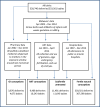Ovulation induction and subfertile untreated conception groups offer improved options for interpreting risks associated with ART
- PMID: 38470554
- PMCID: PMC11052736
- DOI: 10.1007/s10815-024-03060-6
Ovulation induction and subfertile untreated conception groups offer improved options for interpreting risks associated with ART
Abstract
Purpose: To identify and characterise appropriate comparison groups for population studies of health outcomes in ART-conceived births: ovulation induction (OI), subfertile untreated and fertile natural conceptions. Our secondary objective was to examine whether known risks of pregnancy complications and adverse birth outcomes in ART births are elevated in comparison with subfertile (untreated and OI) conception groups.
Methods: We linked State and Commonwealth datasets to identify all live and stillbirths (≥ 20 weeks) in Western Australia from 2003 to 2014 by method of conception. Demographic characteristics, maternal pre-existing conditions, adverse obstetric history and pregnancy complications were compared across conception groups. Generalised estimating equations were used to estimate adjusted risk ratios (aRRs) and 95% confidence intervals (CI) for pregnancy complications and birth outcomes in singletons.
Results: We identified 9456 ART, 3870 OI, 11,484 subfertile untreated and 303,921 fertile naturally conceived deliveries. OI and subfertile untreated groups more closely resembled the ART group than the fertile group; however, some differences remained across parity, maternal age, pre-existing conditions and obstetric history. In multivariate analyses, ART singletons had greater risks of placental problems (e.g. placenta praevia aRR 2.42 (95% CI 1.82-3.20)) and adverse birth outcomes (e.g. preterm birth aRR 1.38 (95% CI 1.25-1.52)) than the subfertile untreated group, while OI singletons were more similar to the subfertile group with higher risk of preeclampsia and gestational diabetes.
Conclusion: OI and subfertile untreated conception groups offer improved options for interpreting health outcomes in ART births. Pregnancy complications (particularly placental disorders) and adverse outcomes at delivery are more common following ART.
Keywords: ART outcomes; Assisted reproductive technology; IVF; Ovulation induction; Subfertility.
© 2024. The Author(s).
Conflict of interest statement
Professor Hart is the Medical Director of Fertility Specialists of Western Australia and National Medical Director of City Fertility Clinic, a shareholder in CHA SMG; he has received educational sponsorship from MSD, Merck-Serono, Origio, Igenomix and Ferring Pharmaceuticals; Adjunct Clinical Professor John Yovich was the Medical Director and a shareholder in PIVET Medical Centre, recently acquired by Monash IVF (2023). The other authors have no competing interests to disclose.
Figures

Similar articles
-
Pregnancy, birth, and infant outcomes by maternal fertility status: the Massachusetts Outcomes Study of Assisted Reproductive Technology.Am J Obstet Gynecol. 2017 Sep;217(3):327.e1-327.e14. doi: 10.1016/j.ajog.2017.04.006. Epub 2017 Apr 8. Am J Obstet Gynecol. 2017. PMID: 28400311 Free PMC article.
-
Adverse pregnancy, birth, and infant outcomes in twins: effects of maternal fertility status and infant gender combinations; the Massachusetts Outcomes Study of Assisted Reproductive Technology.Am J Obstet Gynecol. 2017 Sep;217(3):330.e1-330.e15. doi: 10.1016/j.ajog.2017.04.025. Epub 2017 Apr 25. Am J Obstet Gynecol. 2017. PMID: 28455086 Free PMC article.
-
Complications and adverse outcomes in pregnancy and childbirth among women who conceived by assisted reproductive technologies: a nationwide birth cohort study of Japan environment and children's study.BMC Pregnancy Childbirth. 2019 Feb 20;19(1):77. doi: 10.1186/s12884-019-2213-y. BMC Pregnancy Childbirth. 2019. PMID: 30786865 Free PMC article.
-
Pregnancy and birth outcomes in couples with infertility with and without assisted reproductive technology: with an emphasis on US population-based studies.Am J Obstet Gynecol. 2017 Sep;217(3):270-281. doi: 10.1016/j.ajog.2017.03.012. Epub 2017 Mar 18. Am J Obstet Gynecol. 2017. PMID: 28322775 Free PMC article. Review.
-
The health of children conceived by ART: 'the chicken or the egg?'.Hum Reprod Update. 2019 Mar 1;25(2):137-158. doi: 10.1093/humupd/dmz001. Hum Reprod Update. 2019. PMID: 30753453 Review.
References
-
- Qin J, Liu X, Sheng X, Wang H, Gao S. Assisted reproductive technology and the risk of pregnancy-related complications and adverse pregnancy outcomes in singleton pregnancies: a meta-analysis of cohort studies. Fertil Steril. 2016;105(73–85):e1–6. - PubMed
-
- Bosdou JK, Anagnostis P, Goulis DG, Lainas GT, Tarlatzis BC, Grimbizis GF, et al. Risk of gestational diabetes mellitus in women achieving singleton pregnancy spontaneously or after ART: a systematic review and meta-analysis. Hum Reprod Update. 2020;26:514–544. doi: 10.1093/humupd/dmaa011. - DOI - PMC - PubMed
-
- Vermey BG, Buchanan A, Chambers GM, Kolibianakis EM, Bosdou J, Chapman MG, et al. Are singleton pregnancies after assisted reproduction technology (ART) associated with a higher risk of placental anomalies compared with non-ART singleton pregnancies? A Syst Rev Meta-anal BJOG. 2019;126:209–218. - PubMed
MeSH terms
Grants and funding
LinkOut - more resources
Full Text Sources
Medical

